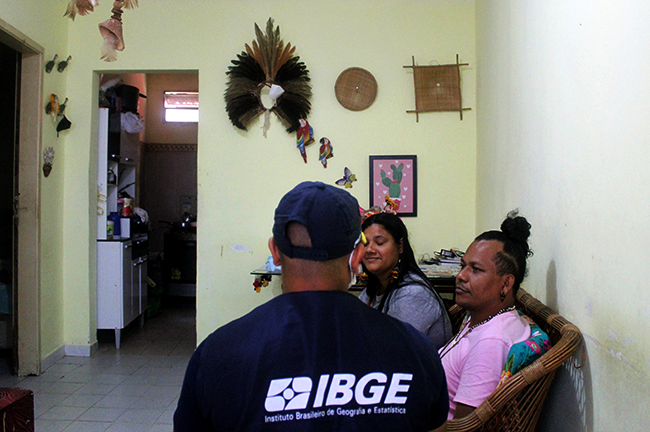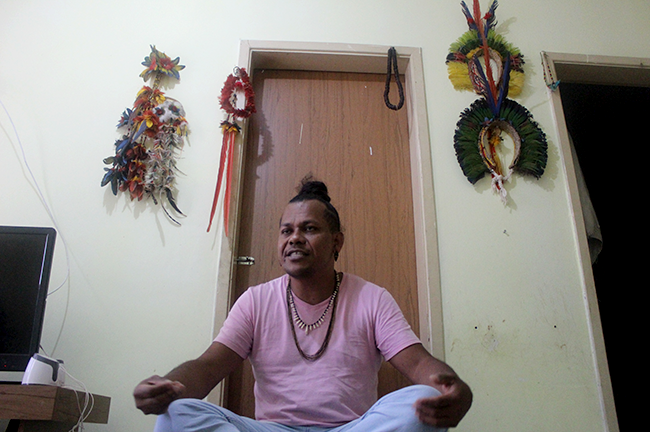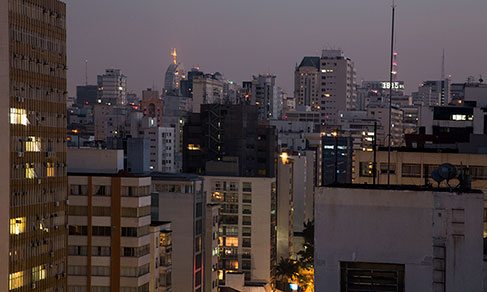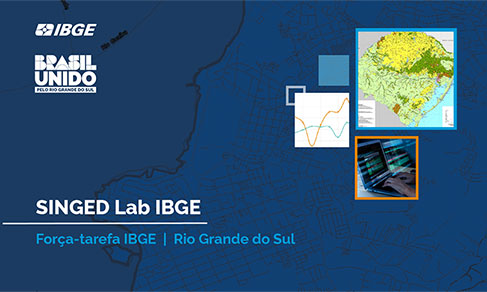Censo 2022 em campo
In Salvador: Census work to count Indigenous population in urban contexts
September 26, 2022 02h00 PM | Last Updated: October 03, 2022 07h11 PM
Highlights
- In the balance of the first month of collection of the 2022 Census, in August, the population who declared themselves as Indigenous in the Brazilian Census has already surpassed half of the total amount seen in the 2010 Census, with 450,140 self-declared Indigenous persons having been enumerated.
- The Census Mapping indicated Indigenous groups in unofficially delimited territories and in places with a high concentration of these populations, including urban areas. The number of areas increased from 146 in the 2010 Census to 879 in the 2020, a growth of 502% in 10 years.
- In the 2022 Census, anyone who selfdeclares Indigenous, in whatever municipality, will be able to inform their ethnicity and the languages they speak.
- “We cannot ignore the fact that there are Indigenous perosns in Salvador and that they also need to be assisted with health, education and access to all public goods. We, Indigenous persons, fight for our recognition, for our existence to be known.” (Genilson Taquari, indigenous Pataxó).

It was a typical urban environment. After getting into a busy street with many cars, pedestrians and small commercial establishments, you turn to the left and go down a large stairway sided by houses. There, in the neighborhood of Alto das Pombas, in Salvador, lives Genilson Taquari.
Taquari, as he is known, descends from the Pataxó Indigenous ethnicity, and has lived in the capital of Bahia for 10 years. Native of the Coroa Vermelha village, in the municipality of Santa Cruz Cabrália (755 km away from Salvador), in the South of Bahia, he studies Law in the Federal University of Bahia (UFBA).
Taquari is an urban Indigenous and explained the kind of prejudice people like him suffer: “The Brazilian society is not prepared to understand the Indigenous person. Schools have been teaching very incipient knowledge about the topic, most of the times common sense knowledge”, he says.
“There are many distortions. Then people think that Indigenous are those who wear a cocar. If there is no cocar on our head, they assume we are not Indigenous. If the hair is not straight and with a specific haircut. Then, they think we should be like this, we have to be painted”, he adds.

 Census interviewed Taquari at his home, in the Alto das Pombas neighborhood, in the capital of Bahia.
Census interviewed Taquari at his home, in the Alto das Pombas neighborhood, in the capital of Bahia. First month of collection of the 2022 Census has already counted 450,140 Indigenous persons across the country
First month of collection of the 2022 Census has already counted 450,140 Indigenous persons across the country
Taquari is not alone. According to the 2010 Census, just over a third of the 896,917 self-declared Indigenous persons in the country lived in urban areas (36.22%). Although this index was low in the North Region (17.96%), it was almost half in the Northeast (49.15%) and was very close to 80% in the Southeast (79.96%).
São Paulo/SP, for instance, was the 4th municipality with the largest indigenous population in the country, the largest outside the North Region, with 12,987 inhabitants.
In addition, 4 out of 10 Indigenous persons lived outside officially demarcated lands in the last census (42.32%). In Bahia, this index reached 72.03%. Salvador was the third municipality with the largest Indigenous population living outside officially demarcated areas, with 7,563 self-declared inhabitants, just below the numbers recorded in São Paulo/SP (12,024) and São Gabriel da Cachoeira/AM (11,682).
This is also the case for Jerry Matalawê, who lives in the Piatã neighborhood. Fifteen years ago, the Pataxó, born in the Barra Velha Indigenous Land, in the region of the municipality of Prado (789 km from Salvador), also in the south of the state, moved to Salvador for work with his wife Merk Pataxó and their daughter, Am'ni Pataxó, from the Coroa Vermelha village.
“We must think that the Indigenous peoples, from the point of view of their living, "good living" as we call it, tends to be always related to territory. The idea of collectivity, the idea of mutual caring. And leaving the Indigenous territory to be in town is not always a free choice", he claims.
Coordinator of Policies for Indigenous Peoples in Bahia, Jerry believes he is in a privileged position in relation to the majority of the Indigenous persons who migrated to the urban area: “We know that most of our relations who came here were alone, and then they lose contact with culture, language and this idea of collectivity”, he says.
“Living in urban territory poses many challenges. Because it puts us in a situation of fulfilling what colonizers have always wanted: the ideal of integration, that is, that we begin to experience and become very similar to Non-Indigenous persons”, completes Jerry.
But even in this adverse context, his wife explains the importance of keeping traditions alive: “We were aware of the difficulty that we would have here to keep our culture, because it is different in the village. But anyway, as a mother, I tried my best to pass this on to our daughter. We have our singing, we have our food, we have our dance”, says Merk.
“And I've done everything for Am'ni not to lose those traditions either. So, I think it gives her ground not to fail in recognizing herself as an Indigenous person even though she is in Salvador”, he adds.
In the 2022 Census, anyone who declares themselves Indigenous, in whatever municipality they are, will be able to inform their ethnicity and which languages are spoken by their people, being able to declare up to 2 ethnicities and up to 3 languages. Even if the person does not know how to answer these questions, their self-identification will be accepted by the enumerator.
Census Mapping for the 2022 Census sought to map areas of large Indigenous population outside the delimited lands
To portray the country's Indigenous population as faithfully as possible, the Census sought a way for more people to declare themselves as such. In areas with a large Indigenous population, if the respondent gives another answer in terms of color or race, the follow-up question “Do you consider yourself indigenous?” appears.
However, as almost half of the Indigenous population lived outside the delimited areas in 2010, the question could not be limited to those places.
As a result, the Census Mapping had to work in different ways to map Indigenous groups in unofficially delimited territories and places with a high concentration of those populations, including urban areas.
“The survey was based on administrative records, combined with field work by the agencies,” explained Leonardo Afonso, coordinator of the Census Mapping in Bahia.
“The main administrative data came from the National Electric Energy Agency (ANEEL), through the records of households benefiting from a differentiated tariff, data from the 2010 Census with households visited where there were people declaring themselves Indigenous, and the list of villages by municipality from the Special Secretariat of Indigenous Health (SESAI)”, added Leonardo.
The agencies’ fieldwork was also essential to find Indigenous groups outside demarcated territories, as explained by Leidson Júnior, coordinator of the 2022 Census Area in Porto Seguro (707 km from Salvador):
“We held meetings with the National Indian Foundation (FUNAI) and obtained a file with a list of georeferenced villages that were under the responsibility of the institution. With this file in hand, we performed the intersection with the sectoral mesh of the Porto Seguro area to obtain the list of villages. As a result, we identified the groups in the sectos that had non-sectored villages, according to the criteria of the Census Mapping”, he said.
This work made the groups outside of mapped Indigenous lands increase from 146 in the 2010 Census to 879 in 2020. A growth of 502% in 10 years.
With all this work, in the balance of the first month of collection of the 2022 Census, the population who self-declared Indigenous in the census in Brazil had already exceeded half of all that was counted in the 2010 Census (896,917). As of August 29, 450,140 self-declared Indigenous persons had been registered.
In Bahia, the Indigenous population registered in the first month of the 2022 Census (81,992 inhabitants) has already surpassed that of the entire 2010 Census (60,120), and is the 2nd largest in the country, in absolute terms, so far, behind only that counted in Amazonas (152,218).
The Census Mapping identified 7,103 Indigenous locations distributed in 827 Brazilian municipalities. Of the total number of locations, only 632 are officially delimited Indigenous lands (8.9%). The vast majority are formed by 5,494 Indigenous groups (77.3%), being 4,648 within Indigenous lands and 846 outside these territories.
There are also 977 (13.8%) areas called “other Indigenous locations”, those where these peoples are present, but at a minimum distance of 50 meters between households.
In Bahia, 134 locations were mapped in 39 municipalities. Of these, 35 are officially delimited lands (26.1%), 55 are groups (41.0%) and 44 were considered “other Indigenous locations” (32.8%).
The states with the most Indigenous locations are in the northern region of the country: Amazonas (2,602), Roraima (587) and Pará (546).

Identity and public policies: the importance of declaring oneself Indigenous
But what is the importance, after all, of the Indigenous persons outside their village or officially delimited land declaring themselves as such in the Population Census?
“First, because it's important for you to know who you are. And once you express your identity, your being, this will also contribute to public policy-making”, answers Genilson Taquari, who adds: “We need, mostly, in large cities, a policy more focused on the Indigenous sector. We cannot ignore the fact that there are Indigenous persons in Salvador and that they also need to be assisted with health care, education and have access to all public goods. We, Indigenous, fight for our recognition, for people to know that we exist”.
Taquari mentions, as examples of positive practices that can be brought up by the Census, the promotion of debate and events, aimed at valuing these peoples.
For Jerry Matalawê, “Brazilians' big debt is knowing their past”, and the 2022 Census is allowing many people in big cities to rescue their history: “I saw on TV that, in Bahia, the identification of persons surpassed that of the 2010 Census. This is very interesting. And I think this also has to do with the level of visibility that the theme has achieved”
He adds: “This creates opportunity for more people to start seeing one another. And we have noticed, in a very interesting way, how many other people have put themselves in this place of saying 'I am too, I am also part of this fight'. Because there is a saying that goes like this: ‘Everyone has Indigenous blood. Some have it in their veins; others, in their hands; others, in their soul.'”
The two interviewees, Taquari and Jerry, live in neighborhoods 20km away from each other. With the urban Indigenous population spread throughout the city of Salvador, the Technical Coordination of the Census decided to expand the delimitation of Operational Interest Areas (AIO) as much as possible - in order to make it possible for a significant number of households to answer the follow-up question when the resident does not self-declare Indigenous in the matter of "color or race".
André Urpia, IBGE's superintendent in Bahia, explained and celebrated the decision: "It has brought us quality information, giving us greater precision about the real size of the Indigenous population portrayed in these data."




















